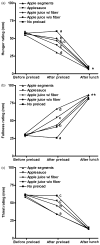The effect of fruit in different forms on energy intake and satiety at a meal
- PMID: 19110020
- PMCID: PMC2664987
- DOI: 10.1016/j.appet.2008.12.001
The effect of fruit in different forms on energy intake and satiety at a meal
Abstract
Consuming whole fruit reduces ratings of satiety more than fruit juice, but little is known about the effects of different forms of fruit on subsequent energy intake. This study tested how consuming preloads of apples in different forms prior to a meal (apple, applesauce, and apple juice with and without added fiber) influences satiety and energy intake at meal. Preloads were matched for weight, energy content, energy density, and ingestion rate. Once a week for 5 weeks, 58 adults consumed one of four preloads (266 g; 125 kcal [523 kJ]), or no preload (control), followed by a test meal consumed ad libitum 15 min later. Results showed that eating apple reduced lunch energy intake (preload+test meal) by 15% (187+/-36 kcal [782+/-151 kJ]) compared to control (p<0.0001) and decreased energy intake compared to applesauce and both juices. Fullness ratings differed significantly after preload consumption (apple>applesauce>both juices>control). Overall, whole apple increased satiety more than applesauce or apple juice. Adding naturally occurring levels of fiber to juice did not enhance satiety. These results suggest that solid fruit affects satiety more than pureed fruit or juice, and that eating fruit at the start of a meal can reduce energy intake.
Figures


References
-
- Almiron-Roig E, Drewnowski A. Hunger, thirst, and energy intakes following consumption of caloric beverages. Physiology & Behavior. 2003;79:767–773. - PubMed
-
- Almiron-Roig E, Flores SY, Drewnowski A. No difference in satiety or in subsequent energy intakes between a beverage and a solid food. Physiology and Behavior. 2004;82:671–677. - PubMed
-
- Beridot-Therond ME, Arts I, Fantino M. Short-term effects of the flavor of drinks on ingestive behaviors in men. Appetite. 1998;31:67–81. - PubMed
-
- Bolton RP, Heaton KW, Burroughs LF. The role of dietary fiber in satiety, glucose, and insulin: studies with fruit and fruit juice. American Journal of Clinical Nutrition. 1981;34:211–217. - PubMed
-
- Burton-Freeman B. Dietary fiber and energy regulation. Journal of Nutrition. 2000;130:272S–275S. - PubMed
Publication types
MeSH terms
Grants and funding
LinkOut - more resources
Full Text Sources
Medical

